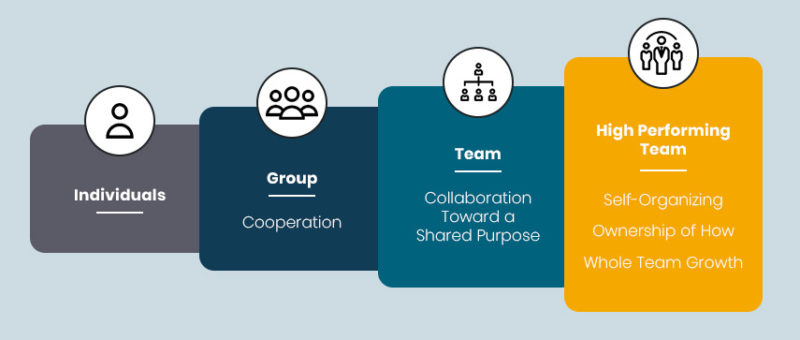
Agilemania
Agilemania, a small group of passionate Lean-Agile-DevOps consultants and trainers, is the most tru... Read more
![]() Get Your AI-Enabled Scrum Master Certification for Just ₹1,500 (Save 85%)!
Get Your AI-Enabled Scrum Master Certification for Just ₹1,500 (Save 85%)!
Scrum.Org
SAFe®
ICAgile
Scrum Alliance
Technical Agility
Kanban
Business Analysis
Project Management
AI-Enabled
Agilemania Academy
Scrum.Org
SAFe®
ICAgile
Scrum Alliance
Technical Agility
Kanban
Business Analysis
Project Management
AI-Enabled

Agilemania
Agilemania, a small group of passionate Lean-Agile-DevOps consultants and trainers, is the most tru... Read more

I am dedicating this very first article of mine to those who have heard or have even yet to hear of this mysterious term called 'self-organizing teams', and are wondering if they even exist in the first place.
When I was younger, I was occasionally told by people (unfortunately now I do not recall anymore who they were...), to observe how a group of ants work together. "What? Why? I mean, what for?" as these questions silently crowded my head. Predictably enough, I brushed them away because at that time, I could not understand why I was asked to watch a bunch of ants crawling on the ground. I simply could not understand the underlying meaning behind watching a bunch of ants crawling on the ground. I thought to myself, "Why on earth would I spend my time watching a bunch of ants in the first place?" I brushed these thoughts of mine off as I could not understand at that point of time. Fast forward to today, 21 November 2019, me seated in front of my laptop, where I finally realized why I think at least, why I was told what I was told back then.
Img Credit: Tom Hussey
What do we normally see in most enterprise organizations currently? Do we see multiple layers of hierarchy that seem almost impossible to break down, yet somehow must be broken down? Or do we see a structure that emerged overtime in order to sustain business, customers, and employees? If the first question was asked a few decades ago, I reckon most probably the answers would revolve 80% around the latter where people actually appreciated and preferred such structures, because it offered them nothing more than simplicity, security, and stability.
However, if we were to ask ourselves that question now, I'd like to implore the ones who are reading this now, to think a little bit more carefully about what you choose to see. I will explain why later in this article. First things first, we are living in a VUCA world. Yes, we have now stumbled upon yet another fancy buzzword for Volatility, Uncertainty, Complexity, and Ambiguity in the year of 2019. In a world where things are changing and evolving at a rate so fast, in fact even faster than our own fickle selves changing our minds about the clothes we are wearing before we go on our first date, we simply cannot afford to waste our time waiting for decision-making to take place within the multiple layers of hierarchical structure.
I'll be very honest here, I strongly believe that our people and our teams genuinely want to get things done at work. Why else do we go to work for? Teams do not want to be told by management constantly what needs to get done and how to get them done. Teams do not want to have to wait for weeks for a simple decision if the font size can be changed from 14 to 16 or not. Teams do not want to feel that their efforts have only a minimal impact on the organization and customers. Instead, our teams want to feel empowered to take their own informed decisions to get things done.
Our teams want to be able to know that every single thing that they do is contributing to the bigger picture. Our teams want to always deliver the most value possible to the customers, as much as they could, even when they know they can do so much better but sadly will they have to wait for the upcoming year to make it happen. As leaders, we need to be able to provide to our teams at work, an environment that fosters and supports mastery, purpose, and autonomy. When that happens, that is when we will be able to say that we are now building our self-organizing, agile teams.
Now, you may be wondering and asking, "Tell me about this mythical term called 'self-organizing teams' and the secret to getting/building/sourcing/training/... them!" Well, unfortunately, even I myself do not have an answer to that yet, because I am, just like most of you, stuck within the multiple layers of hierarchy in the organization. I am still in my journey, searching and exploring for answers with like-minded people. What I do know however, that if there's one thing that could help - that if we are serious and committed in building self-organizing teams, we first need to learn how to become a butterfly.
So, what are you seeing now? Do you see walls or do you see butterflies?

Organizations can start by reducing bureaucratic layers, empowering teams with decision-making authority, and fostering a culture of trust and collaboration.
Benefits include faster decision-making, increased innovation, higher employee satisfaction, and improved responsiveness to customer needs.
Key components include fostering a supportive culture, providing necessary resources, empowering team members, and encouraging continuous learning and improvement.
Agilemania, a small group of passionate Lean-Agile-DevOps consultants and trainers, is the most trusted brand for digital transformations in South and South-East Asia.
WhatsApp Us
We will get back to you soon!
For a detailed enquiry, please write to us at connect@agilemania.com

